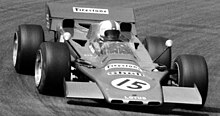This article needs additional citations for verification. (June 2018) |
 Dave Walker in the 56B at Zandvoort | |||||||||
| Category | Formula One USAC IndyCar | ||||||||
|---|---|---|---|---|---|---|---|---|---|
| Constructor | |||||||||
| Designer(s) | Colin Chapman (Technical Director) Maurice Philippe (Chief Designer) | ||||||||
| Predecessor | 72 (F1) 42 (USAC IndyCar) | ||||||||
| Successor | 72 (F1) 64 (USAC IndyCar) | ||||||||
| Technical specifications | |||||||||
| Chassis | Aluminium monocoque | ||||||||
| Suspension (front) | Double wishbones, inboard coil springs over dampers | ||||||||
| Suspension (rear) | Double wishbones, inboard coil springs over dampers | ||||||||
| Engine | Pratt & Whitney STN76[1] gas turbine mid-mounted | ||||||||
| Transmission | Manual single-speed direct-drive planetary gear set[2] Four-wheel drive | ||||||||
| Power | 500–600 hp (373–447 kW)[3] | ||||||||
| Weight | 612kg (USAC IndyCar) 600kg (F1) | ||||||||
| Fuel | STP (USAC IndyCar) Shell (F1) | ||||||||
| Tyres | Firestone | ||||||||
| Competition history | |||||||||
| Notable entrants | Gold Leaf Team Lotus (F1) World Wide Racing (F1) | ||||||||
| Notable drivers | |||||||||
| Debut | 1968 Indianapolis 500 (USAC IndyCar) 1971 Dutch Grand Prix (F1) | ||||||||
| |||||||||
| n.b. Unless otherwise stated, all data refer to Formula One World Championship Grands Prix only. | |||||||||
The Lotus 56 was a gas turbine-powered four-wheel-driven racing car, designed by Maurice Philippe as Team Lotus's STP-backed entry in the 1968 Indianapolis 500. All three cars entered and retired from the race with Joe Leonard's car expiring while leading just eight laps from the finish.
A variant designated the Lotus 56B was entered in three races in the 1971 Formula One season but with little success.
The 4WD concept was also used in the 1969 Lotus 63 F1 car, and the wedge shape became a prominent feature of the world championships winning Lotus 72.
- ^ "Pratt & Whitney". statsf1.com. Retrieved 7 March 2023.
- ^ "1968 Lotus Type 56 Specifications". conceptcarz.com. Retrieved 7 March 2023.
- ^ "Lotus 56B Pratt & Whitney". f1technical.net. Retrieved 7 March 2023.